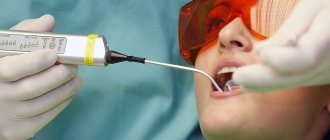Causes of a crack in the root of a tooth
Not all patients understand why a root crack occurs in a living tooth. The reason lies in the uneven distribution of the load. Moreover, the load can be strong and sudden, or it can accumulate over years and lead to the appearance of a crack after some time.
Typically, the cause of a crack is caused by the following factors:
- domestic trauma
- blow, fall, sudden load while chewing; - improper treatment
- strong pressure when cleaning canals or filling the root can injure the walls and in the future, with the slightest excessive load, cause a crack in the root; - error during prosthetics
- strong pressure when installing a pin or the manufacture of inappropriate dentures that unevenly distribute the load during chewing, leading to injury; - Bruxism
- unconscious clenching of the jaws, for example, during sleep, leads to a load that the patient does not notice and cannot control.
Symptoms
The most common symptoms are:
- pain that does not have an exact location (radiates to different parts of the dentition);
- increased sensitivity of the enamel (this is strongly felt when eating hot or cold foods);
- severe discomfort while chewing food.
If vertical damage leads to pulpitis, then the patient develops a characteristic putrid odor from the oral cavity, which cannot be gotten rid of even after cleaning.
As tissue necrosis develops, the color of the enamel may change, the gums may swell, and become very painful when pressed. Very often the damage affects the root, and this leads to severe loosening of the tooth.
Let's talk about what you can do when your front teeth are loose - how to strengthen them at home and in dentistry.
Types of tooth root crack
Pressure can be applied both vertically and perpendicularly to the crown. The following types of cracks are distinguished:
- oblique crack of a tooth
- a diagonal fracture, usually the healthy part is much larger, and the doctor can save the tooth by removing the affected part; - transverse crack of a tooth
- part of the root is completely broken off and deprived of nutrition; the closer the crack is to the coronal part, the higher the risk of complications; - longitudinal crack in the root of a tooth
- the fracture runs vertically, along the axis of the root, often accompanied by a fracture of the crown; - comminuted tooth crack
- multiple root fractures intersecting with each other.
Installation of crowns
Prosthetics with crowns is a reasonable way to restore quality of life and restore the functionality of a severely damaged unit. Today it is possible to make beautiful and comfortable dentures at an affordable price.
Metal-ceramic crowns on teeth
If chewing teeth have been damaged, then the most affordable way to restore them is the use of metal-ceramics. Such crowns for sixth teeth or other molars will be strong and aesthetically pleasing. The ceramic coating visually brings them closer to natural teeth, and the solid metal base allows you to chew familiar foods without fear.
Metal ceramics
– a compromise look that combines comfort, quality and attractiveness. Chewing teeth actively work under significant load; the metal will be stronger than its own enamel.
The method of making such crowns:
- An impression is made.
- Based on the wax model, a one-piece structure is created in the dental laboratory, repeating all the shapes of the recreated dental crown.
- Layers of ceramic are applied to the model, each of which is baked at high temperature.
It is recommended to follow the usual precautions - do not eat hot and ice-cold food at the same time. With a sharp change in temperature, the ceramic surface may crack. This way of eating is also harmful to the “native” enamel.
How much does it cost to make a metal-ceramic crown on a tooth? For me – from 17,900 rubles for 1 tooth. If you need several prostheses, then flexible pricing applies. Accordingly, if the patient wants to restore a tooth not with metal-ceramics, but with ceramics, then there are no problems, he will be offered only the best materials e-max and zirconium dioxide.
Previously, in case of serious damage, a pin and a filling were used to recreate the stump in order to place a crown on the tooth on such a support. Nowadays, more and more people are switching to Cerec technology and restoring teeth using single “crown + root” modules, which is stronger and more reliable. And most importantly, it is much faster in time and costs less in total:
Come to me, Dr. Sergei Samsakov, and we will assess the condition of the problematic tooth and choose a method to restore it. If a tooth is broken, let's see if it is possible to put a crown and what material is better to choose. All manipulations are performed without pain, in a comfortable environment.
Root crack diagnosis
Only a doctor can diagnose an injury. First, the specialist makes a preliminary diagnosis based on the patient’s symptoms and complaints. More detailed research is required to clarify.
- Instrumental examination.
By tapping the tooth, the doctor determines whether there are irregularities, fractures or bleeding in the root of the tooth. - X-ray.
The image clearly shows the tooth root crack, its location and the severity of the injury. - Electrical exposure
helps determine the condition of the pulp.
Crack in the root of a tooth: what to do
After diagnosis, patients are concerned with the question of whether it is possible to cure a crack in the root of a tooth. It all depends on the severity of the injury, the type of fracture and location. But there is no therapeutic treatment - tablets, ointments and injections; in any case, surgical intervention is necessary.
Ⅰ.
In case of a transverse fracture, the tooth can be saved, but the pulp is removed without exception. The doctor cleans and fills the root canals, and fastens the crack with a pin. Now the tooth needs rest and a minimum of chewing load - to reduce mobility, the teeth are splinted, that is, fixed in the correct position with a special splint-onlay.
Ⅱ.
Splintered, vertical and oblique cracks in most cases are only the initial stage of destruction of the root system, and over time the fault will grow. Therefore, depending on the severity of the injury, the doctor removes either part of the root with a crown or the entire tooth. A partially lost tooth can be restored using an inlay on a pin, or a complete tooth can be restored by installing a prosthesis or implant.
Treatment of a crack in the root of a tooth requires following the following recommendations:
- limit the chewing load - it is better to eat soups, cereals and other soft foods, avoid hard foods;
- monitor the temperature - all foods and drinks should be slightly warm, ice cream or hot tea have an undesirable effect on the injured root;
- eliminate pressure - do not open your mouth wide, do not close your jaw too tightly, brush your teeth carefully, avoid blows.
Best Recovery Solutions
Let's look at several particular (and quite popular) cases of restoration in the table below.
| Problem | The best decision |
| If a small piece breaks off | Artistic restoration using composite material |
| If the front tooth is damaged | Installation of veneers or lumineers |
| If the side | Recovery tab |
| If the crown has a large chip or the entire crown has broken off | Artificial crown on a pin or core tab |
| If the roots are healthy | Artificial crown on the core tab |
| If roots need to be removed | Prosthesis on an implant |
Complications and consequences of a root crack
In this situation, timely treatment is important: seeing a doctor at the initial stage will help avoid consequences. If this is not done, you may encounter the following complications:
- abscess.
A crack without treatment can provoke an inflammatory process, which in the future will turn into suppuration of soft tissues and lead to the formation of an abscess. Treatment of a purulent cavity is much longer, more expensive and unpleasant than treatment of a fissure; - phlegmon.
Suppuration, which, unlike an abscess, does not have clear boundaries and does not flow into the formation of a cavity. Cellulitis is a decay of cells that can spread to any tissue in the cavity; - periodontitis.
Inflammation of the periodontium, that is, the tissues surrounding the tooth, leads to their death and the inability to hold the tooth in the gum. The result is the complete loss of one or more teeth; pulpitis. The death of the pulp - the neurovascular bundle of tissues in the tooth through which it receives nutrition. Pulpitis is quite painful and can affect neighboring tissues; - tissue injury.
A root fragment can injure soft tissue. In this case, the doctor will have to extract a piece of the root and remove the infected tissue.
Chips are different
Dental chips are deep injuries that expose the nerve. Such injuries usually cause severe pain and increased sensitivity. It even happens that the tooth bleeds. In this case, it is necessary to treat the root canal and, most likely, remove the nerve. Next, the tooth is filled (if possible) or a crown is placed.
Deep vertical cracks originate at the base of the tooth and rise up to the chewing surface, causing acute pain. It is likely that the area around the root will become inflamed if it becomes infected. Such a tooth will most likely need to be removed, but the final decision is made by the dentist after an examination.
If the tooth has deteriorated due to internal voids, then you will need to take an X-ray to assess the scale of the “catastrophe.”
Typically, specialists determine the size and nature of the cavity, and then make recommendations for restoring the tooth. It happens that a tooth has to be removed because the void continues to grow towards the bone. Moscow metro station Zvezdnaya, Danube Avenue, 23
Prevention of root injuries
The best treatment is disease prevention. To prevent cracks at the root, try to follow a few recommendations:
- be careful and attentive, because half of the cases of root cracks are household injuries, which can be avoided if you take care of yourself and your health;
- carefully choose a clinic and a doctor - before visiting a dentist, check the reviews and ratings of the clinic, certificates and specialist diplomas, do not go to questionable dentists;
- strengthen your teeth - eat healthy foods, do not forget about the importance of calcium and fluoride in strengthening your teeth, choose suitable dental hygiene products.
If symptoms of a root crack occur, do not self-medicate and do not wait for the pain to go away on its own. See your doctor. If the pain is caused by a temporary phenomenon, you will be calm, and if a crack is discovered at the root, treatment at the initial stage will help maintain the health and beauty of your smile, avoid complications and unnecessary expenses.
Dentists' recommendations
If a tooth is cracked, you can save it, but you should make an appointment with your dentist right away. The sooner professional help is provided, the less likely there are complications.
Before visiting a doctor, you should adhere to the following recommendations:
- the load on the injured tooth is completely eliminated;
- take only soft or ground food of medium temperature;
- Every hour, rinse your mouth with antiseptic agents, saline solutions or herbal decoctions.
Experts strongly advise against touching a damaged tooth with your fingers or tongue. You should not loosen it or try to use any popular recommendations. When a tooth is cracked, it can only be saved by going to the dentist.









